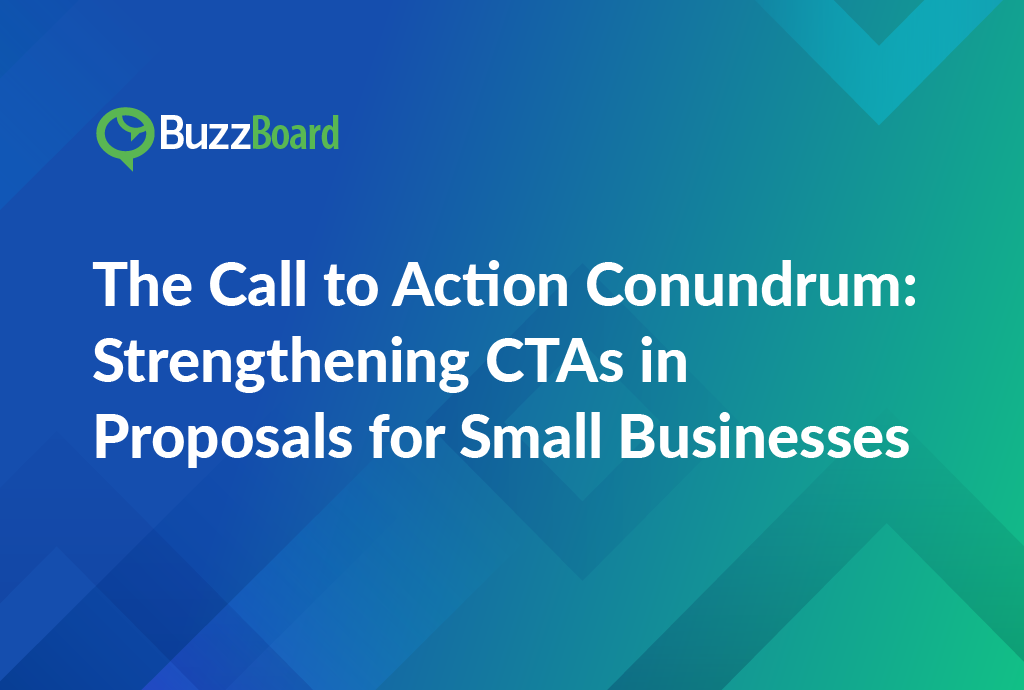Summary
In the competitive world of proposal writing, a well-crafted Call-to-Action (CTA) can be the difference between winning and losing a project. For small businesses, creating an effective CTA can be a daunting task. This article provides actionable tips and strategies to strengthen CTAs in proposals, helping small businesses stand out from the competition and increase their chances of securing new projects. Learn how to craft a compelling CTA that resonates with clients and drives results.
Addressing the Issue of Weak Call to Action in Proposals
Addressing a weak call to action in proposals can be a game-changer for sales professionals, significantly improving the chances of securing client approval. A compelling call to action doesn’t just guide potential clients towards the next steps in the proposal; it also convincingly demonstrates the unparalleled value of your services.
Creating a high-powered call to action demands proficient persuasive writing skills. Proposals should identify and articulate benefits in ways that resonate with potential clients. This strategy can tap into their motivations, bridging the gap between simple interest and concrete action.
To revitalize a lackluster call to action, it’s essential to employ tactics that pique the client’s curiosity and create a sense of urgency. One effective approach is to offer a unique or time-sensitive solution that sets your agency apart from the competition. For instance, you could highlight a cutting-edge digital marketing trend that your agency excels in, emphasizing the potential benefits that small and local businesses can reap by acting promptly.
By doing so, you’re not only generating interest but also creating a sense of FOMO (fear of missing out) among potential clients. This can be particularly effective in industries where trends and technologies are constantly evolving, and businesses that fail to adapt may fall behind.
In addition to offering a unique solution, it’s crucial to clearly articulate the value proposition of your services. Your proposal should clearly outline the benefits that clients can expect to gain from working with your agency. This could include increasing website traffic, boosting customer engagement, or improving conversion rates.
To make your value proposition even more compelling, consider using specific data and statistics to illustrate the potential impact of your services. For example, you could highlight a case study or testimonial from a previous client who has seen significant improvements in their online presence or sales.
Another key aspect of a successful call to action is to create a sense of scarcity or limited-time opportunity. This could be achieved by offering a special promotion or discount for new clients, or by highlighting a limited-time window of opportunity to take advantage of a particular service or technology.
Ultimately, the goal of a call to action is to guide your clients toward the next steps of the proposal, whether that’s scheduling a consultation, signing up for a free trial, or committing to a specific package of services. By offering a unique solution, generating interest through urgency, and clearly laying out the benefits of your services, you can create a compelling call to action that drives results and sets your agency apart from the competition.
Some additional tips to enhance your call to action include:
- Using clear and concise language to communicate the benefits of your services
- Creating a sense of exclusivity or VIP treatment for clients who take action
- Offering a clear and easy-to-follow path to the next step, whether that’s a phone call, email, or online form
- Using social proof, such as customer testimonials or industry certifications, to build trust and credibility
- Creating a sense of accountability by offering a guarantee or satisfaction promise
- Using visual elements, such as images or videos, to make your call to action more engaging and memorable
By incorporating these strategies into your call to action, you can create a compelling and effective proposal that drives results and sets your agency up for success.
The Power of Persuasive Writing in Proposals to Strengthen CTAs
In the world of digital marketing, proposals are a crucial step in securing new clients and projects. However, a weak call to action (CTA) can severely undermine conversion rates, leaving potential clients uncertain and unmotivated to take the next step. Astute salespeople must leverage the persuasive power of words to make their proposals compelling, thus facilitating prospective clients’ buy-in.
Securing Client Buy-In: The Initial Challenge
In proposals, the initial challenge often lies in securing client buy-in. Clients need to understand what benefits they will reap from working with your digital marketing agency. This requires illustrating value, displaying expertise, and clarifying how your agency can bolster their business stature in the next steps of the proposal. By doing so, you can demonstrate the tangible benefits of your services and show how they can help the client achieve their goals.
The Importance of Persuasive Writing in Proposals
The effectiveness of persuasive writing in proposals goes beyond simply securing a client’s buy-in. It also prompts them to follow your CTA – the ultimate objective. A feeble call to action in proposals may leave clients baffled, resulting in their inaction. On the other hand, a clear and compelling CTA can motivate clients to take the next step, ultimately leading to conversion.
The Sales Team’s Role in Crafting Persuasive Proposals
The sales team at digital marketing agencies, especially those catering to small and local businesses, must observe this crucial detail. Without employing clear, concise language in your CTA, you risk losing the client’s interest from the outset. This is where persuasive writing techniques come into play. By using persuasive language, you can create a sense of urgency, highlight the benefits of your services, and make your proposal more compelling.
Tips for Crafting Persuasive Proposals
To gain knowledge on crafting apt CTAs and applying persuasive writing in your proposals, follow these tips:
- Identify the client’s pain points and tailor your proposal to address them.
- Use clear and concise language to communicate your value proposition.
- Highlight the benefits of your services and how they can help the client achieve their goals.
- Use persuasive language to create a sense of urgency and motivate the client to take action.
- Make your CTA clear and prominent, ensuring it stands out in your proposal.
Resources for Improving Your Proposal Writing Skills
Take your proposal writing skills to the next level by exploring a wealth of resources designed to enhance your understanding and amplify the impact of your proposals. Whether you’re a seasoned professional or just starting out, refining your proposal writing skills can make all the difference in securing funding, winning contracts, and achieving your goals.
To get started, consider the following resources:
- Online courses and tutorials: Websites like Coursera, Udemy, and edX offer a range of courses on proposal writing, from beginner to advanced levels. These courses can provide valuable insights and practical tips to help you improve your skills.
- Industry publications and blogs: Stay up-to-date with the latest trends and best practices in proposal writing by following industry publications and blogs. These resources often feature expert advice, case studies, and real-life examples to help you refine your approach.
- Professional associations and networking groups: Joining professional associations and networking groups related to your industry can provide opportunities to connect with other proposal writers, share knowledge, and learn from their experiences.
- Books and e-books: There are many excellent books and e-books on proposal writing that can provide valuable insights and practical advice. Look for titles that focus on specific aspects of proposal writing, such as crafting compelling CTAs or applying persuasive writing techniques.
By leveraging these resources and staying committed to continuous learning, you can take your proposal writing skills to the next level and achieve greater success in your professional endeavors.
Take the Next Step: Mastering Persuasive Writing Techniques
To take your proposal writing skills to the next level, familiarize yourself with persuasive writing techniques that could be vital in securing client buy-in and bolstering your proposal’s CTAs. By mastering these techniques, you can create proposals that are not only compelling but also effective in driving conversions.
The power of persuasive writing in proposals cannot be underestimated. By leveraging the persuasive power of words, you can create proposals that are compelling, effective, and ultimately drive conversions. Remember to identify the client’s pain points, use clear and concise language, highlight the benefits of your services, and make your CTA clear and prominent. By following these tips and mastering persuasive writing techniques, you can unlock client buy-in and drive growth for your digital marketing agency.
How Proposal Next Steps Can Contribute to a Strong CTA
A strong call to action (CTA) is the linchpin of any persuasive writing strategy, particularly in proposals where securing client buy-in is crucial. The importance of a CTA cannot be overstated, as a weak one can significantly undermine the potential of your proposal. However, this risk can be mitigated by incorporating clear, concise, and engaging proposal next steps to enhance the effectiveness of your CTA.
The inclusion of proposal next steps provides a clear roadmap for your clients after they have reviewed your proposal, eliminating uncertainty and answering critical questions such as: What is the next step for them? How can they utilize your services? What are the expected timelines or the way forward? A potent CTA that integrates proposal next steps can circumvent the risk of a weak call to action and streamline future interactions, ultimately leading to increased client satisfaction and loyalty.
Persuasive writing in proposals, which includes compelling narratives and evidence-based assertions, intensifies the strength of your CTA and proposal next steps. By aligning your writing with your client’s needs and expectations, you increase the chances of efficiently securing their buy-in. This is particularly important for sales professionals at digital marketing agencies serving small and local businesses, who must be able to effectively communicate the value of their services to their clients.
To reinforce your CTAs and effectively secure client buy-in, it is essential to familiarize yourself with persuasive writing best practices. This includes using clear and concise language, highlighting the benefits of your services, and providing social proof through testimonials and case studies. By incorporating these strategies into your proposal writing, you can create a compelling narrative that resonates with your clients and drives them to take action.
In addition to incorporating persuasive writing best practices, it is also important to ensure that your proposal next steps are clear, actionable, and easy to follow. This includes providing a clear outline of the next steps, including any necessary deadlines or milestones, as well as offering support and guidance throughout the process. By providing a clear roadmap for your clients, you can build trust and confidence in your services, ultimately leading to increased conversions and client satisfaction.
In conclusion, a strong CTA is the backbone of any persuasive writing strategy, and incorporating proposal next steps is a critical component of this strategy. By integrating persuasive writing best practices and clear, actionable proposal next steps, you can create a compelling narrative that drives client buy-in and sets your business up for success. To learn more about strengthening your proposal strategies, refer to this comprehensive guide. Your next step? Implement these strategies and witness the impact they make on your client interactions and conversions. Share your views and experiences on our social media platforms and join the conversation with other sales professionals and business owners.
The Role of Securing Client Buy-in Through Effective CTAs
In the competitive world of small business proposals, the call to action (CTA) is often overlooked, yet it plays a crucial role in securing client buy-in and ultimately, securing the contract. A weak CTA can not only result in losing a contract but also potential revenues, making it a critical component of a successful proposal. When working with local and small businesses, securing client buy-in is vital for the success of your digital marketing campaigns, as it ensures that your proposed solutions are implemented and yield the desired results.
A strong CTA is essential in guiding the client through the decision-making process and directing them towards a specific action. Rather than leaving the decision-making in the clients’ hands, a CTA clearly outlines the next steps for the client, making it easier for them to make an informed decision. This is where persuasive writing in proposals comes into play. It’s not just about listing your services, but about sparking the client’s interest and engaging them with your proposal, ultimately leading to securing their buy-in.
To create an effective CTA, it’s essential to avoid passive phrases like ‘you could consider’ and instead opt for assertive language that resonates with the client. For example, instead of saying ‘you could consider our social media management services’, say ‘start gaining profits by signing up for our social media management services today’. This active language not only engages the client but also underscores the benefits they stand to gain, pushing them towards accepting your proposal.
When crafting your CTA, it’s essential to consider the overall business strategy and ensure that it is contextually appropriate. A CTA should present a specific, achievable action for the client to take following their review of your proposal. This could be as simple as scheduling a consultation or signing up for a free trial. The goal of your CTA is to move the client one step closer to saying ‘yes’ to your proposed solutions, making it a critical component of your proposal.
Mastering the art of effective CTAs takes time and practice, but with persistence and strategic thought, you can turn potentials into profits. To achieve this, it’s essential to understand your target audience, their pain points, and their goals. By crafting a CTA that resonates with your audience and addresses their needs, you can increase the chances of securing their buy-in and ultimately, securing the contract.
In addition to crafting an effective CTA, it’s also essential to ensure that it is prominently displayed in your proposal. This could be in the form of a bold heading, a call-out box, or a highlighted section. By making your CTA stand out, you can draw the client’s attention to it and encourage them to take action.
A strong CTA is a critical component of a successful proposal. By crafting a clear, concise, and persuasive CTA, you can guide the client through the decision-making process, secure their buy-in, and ultimately, secure the contract. Remember to avoid passive language, ensure that your CTA aligns with your overall business strategy, and make it prominent in your proposal. With persistence and strategic thought, you can master the art of effective CTAs and turn potentials into profits.
Examples of Robust and Persuasive Ctas in Proposals for Small Businesses
In the world of proposals, a weak call-to-action (CTA) can be a deal-breaker, potentially costing you valuable business opportunities. A strong CTA, on the other hand, can be the difference between securing client buy-in and watching your proposal gather dust on a shelf. So, how do you ensure your CTAs exude a level of conviction and urgency that compels clients to take action?
The first step is to understand the difference between a robust CTA and a weak one. A weak CTA fails to incite the reader to progress to the proposal’s next steps, leaving them feeling uninspired and unmotivated. Conversely, a strong CTA leverages persuasive writing techniques, compelling the client to act immediately and take the next step.
A meticulously curated proposal’s next steps section is crucial in clearly spelling out the tasks for the client and the stipulated deadlines. This section should be designed to guide the client through the process, making it easy for them to understand what they need to do and by when. A compelling CTA should be included in this section, one that leverages persuasive language to incite the client to take action.
For example, a strong CTA might read, “To tap into your business’s potential today, kindly sign the attached contract and return it by November 23rd.” This CTA underscores urgency with “tap into your business potential today,” stresses immediate action with “sign the attached contract,” and sets a firm deadline with “return it by November 23rd.” This type of CTA creates a sense of FOMO (fear of missing out) and encourages the client to take action quickly.
Another potent CTA may read, “Kickstart your digital marketing results. Click to agree to our proposal, and let’s turbocharge your business.” This CTA melds promising client benefits (kickstart results) with a definitive action (click to agree to our proposal), using persuasive language to visualize an enticing future (turbocharge your business). This type of CTA creates a sense of excitement and anticipation, encouraging the client to take action and experience the benefits for themselves.
Incorporating persuasive writing into proposals and integrating strong CTAs is essential to encourage action and secure client buy-in. Persuasive writing techniques, such as storytelling, emotional appeals, and social proof, can be used to create a compelling narrative that resonates with the client and motivates them to take action.
If your team lacks the expertise to craft compelling CTAs and persuasive proposals, consider enrolling in professional enhancement resources like the Persuasive Writing for Business Proposals Course from Source. This course provides training and guidance on how to write persuasive proposals that drive results, including how to craft effective CTAs that secure client buy-in.
By incorporating persuasive writing and strong CTAs into your proposals, you can increase the chances of securing client buy-in and driving business results. Remember, a weak CTA can be a deal-breaker, while a strong CTA can be the key to unlocking new business opportunities.
Conclusion
In conclusion, the call-to-action (CTA) is a crucial element in proposal writing for small businesses. A well-crafted CTA can make all the difference in securing a project or contract, while a weak or absent CTA can lead to missed opportunities. The article highlights the importance of understanding the client’s needs and pain points, and using this information to create a clear and compelling CTA that resonates with the reader.
By following the tips and best practices outlined in this article, small business proposal writers can strengthen their CTAs and increase their chances of success. This includes using action-oriented language, emphasizing the benefits of the proposal, and making the CTA specific, measurable, and achievable. By doing so, small businesses can stand out from the competition, build trust with potential clients, and ultimately win more projects and grow their business.
]









